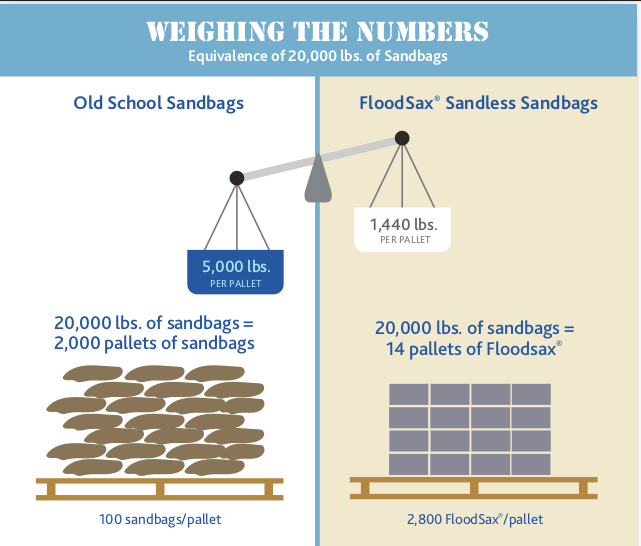FloodSax® Advantage
FloodSax® reusable water filled sandless sandbag patented technology has proven effective worldwide, by preventing millions of dollars in damage to residential and commercial customers, in addition to government and military agencies. Made of super absorbent polymer crystals, interwoven with a natural wood pulp mix, wrapped in a tough fabric case, this unique 9-section internal design offers a powerful flood barrier. FloodSax® can be stacked and staggered dry, and then activated by almost any liquid. Simply put, there is nothing that even comes close!
Why are FloodSax® Sandless Sandbags better flood barrier than old fashioned sandbags?
Sand bags may seem an inexpensive flood barrier to keep floodwater out of homes and businesses but sandbags are environmentally unfriendly and dealing with them is hard work and a back-breaking task that requires a lot of time and effort. They also cost a fortune to store or transport anywhere and they are virtually impossible to deploy quickly.
Pound for pound (or dollar for dollar) FloodSax alternative sandbags can be a more cost effective way of providing flood protection both outside and inside buildings. They are space-saving to store and quick and easy to deploy as highly effective flood barriers.
So here it is in a nutshell, the great sandbags v FloodSax debate.
FloodSax®
- Easy to store, are vacuumed-packed to save even more room and have a minimum 5-year shelf life (but will last way longer than that if stored well).
- Always there for peace of mind so no panic to try to get hold of sandbags if flooding is forecast.
- Can be expanded in water right next to where you need them and stay fully inflated until the flood subsides which could be several weeks or even months.
- Lightweight before they are used with the standard bag weighing just 13 ounces so can be used by people who would not be able to lift sand bags such as the elderly.
- Thousands can be quickly transported in a van, saving on fuel, wages and manpower.
- One can be expanded and put down the toilet to block it from filthy water being forced up by the floodwater backing up through the drains and sewer.
- FloodSax® don’t need sand – one of the earth’s natural resources – and so saves the environment.
- It lets water in, but doesn’t let water out.
- Absorbs fresh water and hazardous liquids
- White color bag allows for quick visual detection of contamination
- 40% more coverage than traditional sandbags
- Vacuum sealed for safe and efficient storage
- Self absorbing, stable and stackable
- 25% larger than any sandbag alternatives
- Contents don’t slide over to one side like other sandless sandbags
- Hundreds can be taken to the scene by one person in a car and thousands transported in a van. This vastly reduces the carbon footprint of transporting the FloodSax.
- Delivering FloodSax is two-thirds cleaner to the environment than delivering sandbags.
- One pallet will contain 480 FloodSax and the cost to the environment is 59g of CO2 per km while one pallet of sandbags is just 50 bags and the cost to the environment is 184g per km.
- Floodsax versus Sandbags- People are shocked to learn that Floodsax cost $1.80 more than a sandbag. If you go to your local hardware store the charge for a prefilled sandbag is $15. Floodsax per bag costs $16.80.
Sandbags
- Must be replaced regularly costing thousands of dollars.
- Can deteriorate if stored for a long time, especially in cold, damp warehouses.
- Very difficult to lift, move and stack into a flood barrier.
- Messy with the sand easily washed out and adding to all the damage if they burst. They are very environmentally unfriendly.
- Difficult and expensive to transport anywhere due to their weight. One box of 20 FloodSax that will easily fit into a car trunk is equal to 20 sandbags on a pallet.
- You’ll need a lot of people to move any number of sandbags anywhere and then build them into flood barriers.
- Ordinary sandbags are heavy and take up vast amounts of storage space in large warehouses, using up land and construction materials to build along with expensive energy to light and AC especially now as energy costs have spiralled out of control.
- Ordinary sandbags need large vehicles such as trucks to take them anywhere at another cost to the environment. This includes the vehicle’s engines churning out carbon monoxide which is toxic to humans and carbon dioxide, a greenhouse gas which is thought to be a major contributory factor to climate change.
- A full truck load of sandbags weighs 18,000kg and the cost to the environment is 1,504g per km.



